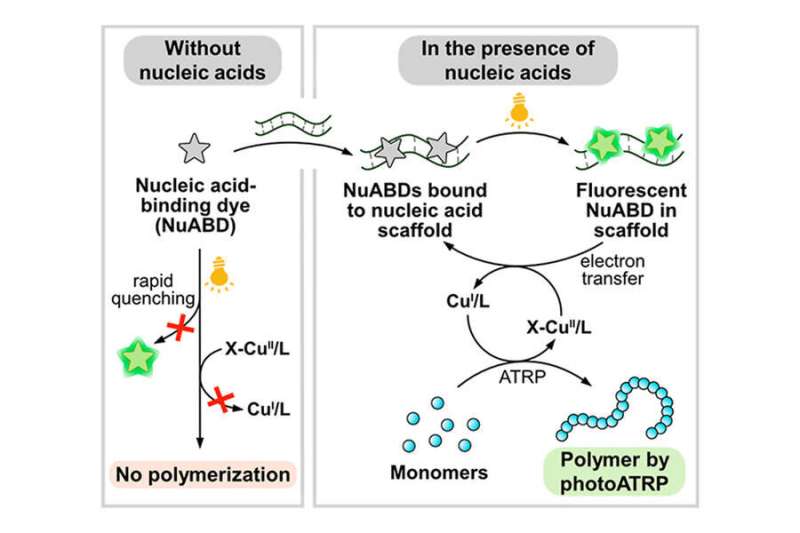This article has been reviewed according to Science X's editorial process and policies. Editors have highlighted the following attributes while ensuring the content's credibility:
fact-checked
peer-reviewed publication
trusted source
proofread
Chemists use nucleic acid binding dyes as photocatalysts for a popular polymerization method

Researchers in Carnegie Mellon University's Department of Chemistry have developed a nucleic-acid-based photocatalyst that can precisely control atom transfer radical polymerization (ATRP), a popular method used to generate a wide range of materials with highly specific, tailored functionalities.
The novel approach took something old—fluorescent dyes that bind to nucleic acids—and turned it into something new—a versatile photocatalyst that allows for precise control over the polymerization reaction.
"Nucleic acid-binding dyes are intriguing fluorescent molecules that illuminate and become activated exclusively in the presence of nucleic acids. Consequently, in our system, polymerization occurs only in the presence of nucleic acids, allowing us to manipulate the process by selecting appropriate nucleic acids as cofactors," said chemistry doctoral student Jaepil Jeong.
The work, published in the Journal of the American Chemical Society, holds promise for advancing the emerging field of nucleic acid-based materials and technologies including logic-controlled photoATRP, nanofabrication and pathogen detection, according to the scientists.
ATRP, the most robust method of controlled polymerization, allows scientists to string together small molecules called monomers in a piece-by-piece fashion, resulting in highly tailored polymers with specific properties. ATRP can be shut down or restarted at will, depending on how the conditions of the reaction are varied.
One way to control the reaction is by using photocatalysts, materials that can change the rate of a chemical reaction by being exposed to light. While there are photopolymerization systems that use simple fluorescent dyes that activate when exposed to light, the Carnegie Mellon team took it one step further using nucleic acid-binding dyes.
Nucleic acid-binding dyes are fluorescent probes that light up after binding to nucleic acids. They have been widely utilized in the fields of nano- and biotechnology for diagnostic and analytical applications.
"As nucleic acid scientists and chemists, we use dyes all the time to visualize DNA or RNA with fluorescent dyes. But now, instead of just detecting the fluorescence, you're using that fluorescence to do polymerization," said Subha R. Das, associate professor of chemistry and a member of Carnegie Mellon's Center for Nucleic Acids Science and Technology.
"In our new system, only when there's DNA or RNA is there fluorescence, so only then will you have the catalysis," Das added.
Because there are nucleic acid-binding dyes that bind to specific DNA or RNA, chemists can design the polymerization process to occur exclusively in the presence of specific sequences or structures of nucleic acids.
Jeong, who is co-advised by Das and Krzysztof Matyjaszewski, the J.C. Warner University Professor of Natural Sciences, was in a position to see the dyes' potential outside of their common usage.
Jeong tested his concept using popular nucleic acid-binding dyes paired with different nucleic acids, from simple salmon DNA and yeast RNA to more complex scaffolds like G-quadruplex DNA and DNA nanoflowers. First, he confirmed that polymerization did not occur without nucleic acid present. Once the nucleic acid scaffolds were added, the dyes bound to them and fluoresced when exposed to light.
Jeong found that, upon binding to nucleic acids, the dyes often exhibited a significantly enhanced fluorescence quantum yield and a prolonged fluorescent lifetime. This enabled efficient electron transfer to the copper catalyst that powers the ATRP reaction. In addition, the researchers noticed increased monomer conversions when they used higher amounts of DNA.
"By leveraging the unique properties of nucleic acid-binding dyes to enable polymerization exclusively in the presence of nucleic acid scaffolds, this new approach offers an attractive way to build macromolecules with complex architectures," said Matyjaszewski, who developed ATRP in 1995 and continues to innovate and improve the technique.
"It also uses ATRP to amplify fluorescent signals by producing high molecular weight polymers only when dye and nucleic acids are present together."
By selecting appropriate nucleic acids as cofactors in the reaction, chemists can achieve better control over the specific polymerization they are trying to achieve.
Along with Jeong, Matyjaszewski and Das, Marco Fantin of the University of Padova is an author on the paper. Fantin, who previously worked as a postdoctoral researcher with Matyjaszewski, provided expertise on the details of the electrochemical aspects of the photocatalytic mechanism.
Jeong, who graduated in May, said he had the privilege of being guided by advisers with diverse expertise, which enabled him to acquire knowledge and skills in two distinct fields: polymer chemistry and nucleic acid engineering.
"The idea to use nucleic acids and binding dyes as photocatalysts was a result of the close and interdisciplinary guidance from my advisers," he said.
More information: Jaepil Jeong et al, Nucleic Acid-Binding Dyes as Versatile Photocatalysts for Atom-Transfer Radical Polymerization, Journal of the American Chemical Society (2024). DOI: 10.1021/jacs.4c03513
Journal information: Journal of the American Chemical Society
Provided by Carnegie Mellon University





















